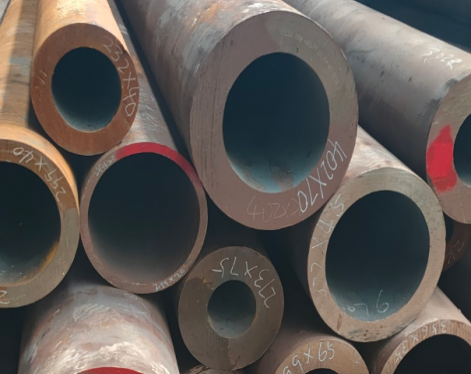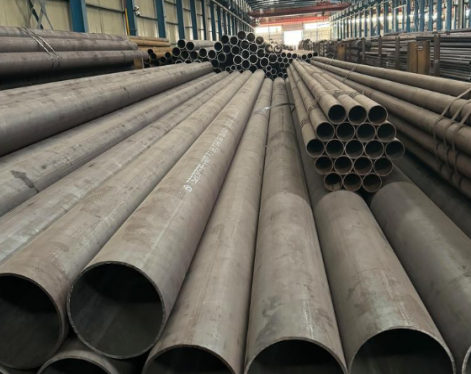With the continuous development of industry, seamless steel pipes (SMLS) are increasingly used in various fields, and their processing technology is also receiving increasing attention. Seamless steel pipes have the advantages of hollow cross-section, uniform wall thickness, smooth inner and outer surfaces, and stable quality. They are widely used in the transmission of fluids such as oil, natural gas, and water, as well as structural parts, mechanical parts, and other fields. This article will introduce the six major processing technologies for seamless steel pipes for structures.
1. Cold drawing
Cold drawing is a commonly used method in the processing of seamless steel pipes. By stretching and compressing the steel pipe through a die, the diameter of the steel pipe is reduced, the wall thickness is reduced, and the length is increased. Cold drawing can produce seamless steel pipes with high precision, uniform wall thickness, and smooth surface, which are widely used in the fields of petroleum, chemical industry, construction, etc.

2. Hot rolling
Hot rolling is to heat the steel pipe to a high temperature state, and then roll it through a die to deform the steel pipe, reduce its size, and reduce its wall thickness. Hot rolling can produce large-diameter, high-strength, high-temperature-resistant seamless steel pipes, which are widely used in boiler tubes, pressure vessels, oil and gas, and other fields.
3. Cold rolling
Cold rolling is to roll the steel pipe at room temperature, and deform the steel pipe, reduce its size and reduce its wall thickness through multiple rolling passes. Cold rolling can produce seamless steel pipes with high precision, smooth surface and uniform wall thickness, which are widely used in automobile, machinery manufacturing and other fields.
4. Extrusion
Extrusion is to add heated billet to the extruder, and under the action of the extrusion rod, the billet flows out through the die to form a pipe of the required shape and size. Extrusion can produce seamless steel pipes with small diameter, thin wall thickness and high precision, which are widely used in aerospace, automobile manufacturing and other fields.
5. Straightening Processing
Straightening processing is to straighten the manufactured seamless steel pipe to achieve the specified straightness and straightness. Straightening processing can improve the quality and stability of seamless steel pipes, making them less prone to bending and deformation during transportation and use. Straightening processing is widely used in the manufacturing and processing of various seamless steel pipes.
6. Polishing Processing
Polishing processing is to treat the surface of seamless steel pipes to improve their surface finish and aesthetics. Polishing processing can be carried out by mechanical polishing, chemical polishing and electrochemical polishing. The appropriate polishing method is selected according to different application requirements. Polishing processing can improve the corrosion resistance of seamless steel pipes and extend their service life, making them more widely used in petrochemical, food and medicine and other fields.
The above are the six major processing technologies for seamless steel pipes for structures. These technologies can be selected and used according to different needs and material properties to produce high-quality and high-performance seamless steel pipes. With the continuous development of science and technology, these processing technologies are also constantly improving and perfecting, providing a broader space for the application of seamless steel pipes.
1. Cold drawing
Cold drawing is a commonly used method in the processing of seamless steel pipes. By stretching and compressing the steel pipe through a die, the diameter of the steel pipe is reduced, the wall thickness is reduced, and the length is increased. Cold drawing can produce seamless steel pipes with high precision, uniform wall thickness, and smooth surface, which are widely used in the fields of petroleum, chemical industry, construction, etc.

2. Hot rolling
Hot rolling is to heat the steel pipe to a high temperature state, and then roll it through a die to deform the steel pipe, reduce its size, and reduce its wall thickness. Hot rolling can produce large-diameter, high-strength, high-temperature-resistant seamless steel pipes, which are widely used in boiler tubes, pressure vessels, oil and gas, and other fields.
3. Cold rolling
Cold rolling is to roll the steel pipe at room temperature, and deform the steel pipe, reduce its size and reduce its wall thickness through multiple rolling passes. Cold rolling can produce seamless steel pipes with high precision, smooth surface and uniform wall thickness, which are widely used in automobile, machinery manufacturing and other fields.
4. Extrusion
Extrusion is to add heated billet to the extruder, and under the action of the extrusion rod, the billet flows out through the die to form a pipe of the required shape and size. Extrusion can produce seamless steel pipes with small diameter, thin wall thickness and high precision, which are widely used in aerospace, automobile manufacturing and other fields.
5. Straightening Processing
Straightening processing is to straighten the manufactured seamless steel pipe to achieve the specified straightness and straightness. Straightening processing can improve the quality and stability of seamless steel pipes, making them less prone to bending and deformation during transportation and use. Straightening processing is widely used in the manufacturing and processing of various seamless steel pipes.
6. Polishing Processing
Polishing processing is to treat the surface of seamless steel pipes to improve their surface finish and aesthetics. Polishing processing can be carried out by mechanical polishing, chemical polishing and electrochemical polishing. The appropriate polishing method is selected according to different application requirements. Polishing processing can improve the corrosion resistance of seamless steel pipes and extend their service life, making them more widely used in petrochemical, food and medicine and other fields.
The above are the six major processing technologies for seamless steel pipes for structures. These technologies can be selected and used according to different needs and material properties to produce high-quality and high-performance seamless steel pipes. With the continuous development of science and technology, these processing technologies are also constantly improving and perfecting, providing a broader space for the application of seamless steel pipes.









